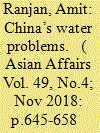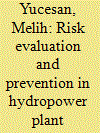|
|
|
Sort Order |
|
|
|
Items / Page
|
|
|
|
|
|
|
| Srl | Item |
| 1 |
ID:
161448


|
|
|
|
|
| Summary/Abstract |
This article looks at the problems facing China in regard of its water supply and usage. It considers China's available water resources and their uses, the growing water pollution, and the water management system adopted by China to secure the country's future. This includes small and large-scale projects, dams, the South-to-North Water Diversion Project/South-North Water Transfer Project (SNWDP/SNWTP) or Nanshuibeidiao, and the Sponge Cities Initiative. It also looks at some of the policy issues and relevant legislative frameworks developed to respond to the problem. This article argues that despite the measures taken by the Chinese government, water remains an area of concern for China.
|
|
|
|
|
|
|
|
|
|
|
|
|
|
|
|
| 2 |
ID:
143895


|
|
|
|
|
| Summary/Abstract |
Good governance is an essentially contested concept. In Asian countries, economic efficiency and macro-economic projects have predominantly been pursued with the aim of promoting national, aggregate measurements of development. Hydroelectric power generation projects have played a central role in the national planning of several regional states as part of an attempt to achieve these goals. Even by their own terms of reference, however, hydroelectric power projects have at most a mixed record of success, and are increasingly criticized with regard to their negative impact on the environment, and upon vulnerable groups. The government of Malaysia has embraced the “developmental state” model, and this is best illustrated by governance initiatives and resource exploitation in the East Malaysian states of Sarawak and Sabah and their respective “development corridors”. Sarawak’s Corridor of Renewable Energy (SCORE) is the most visible sign of Malaysia’s macro-economic hydroelectric development focus, as Sabah’s corridor focuses on trade, investment, and tourism. This article takes a critical perspective towards good governance, emphasizing that it should function in the interests of all society, but in particular the most vulnerable. It therefore addresses the impact of Malaysian hydroelectric development policies on one of the most vulnerable sections of Malaysian society, the indigenous peoples of Sarawak. The findings cast doubt on the validity of continued prioritization of hydroelectric dam construction as a cornerstone of government energy and development policy.
|
|
|
|
|
|
|
|
|
|
|
|
|
|
|
|
| 3 |
ID:
163525


|
|
|
|
|
| Summary/Abstract |
Hydropower generation facilities are becoming increasingly popular in many parts of the world. One of the main reasons for this situation is that the resource reserves such as coal, petroleum and natural gas, which are called conventional energy sources, decrease day by day and their prices rise. So the efficient operation of hydroelectric power plants has become very important. When these plants are operated, it is possible to cause many hazards, including injury, illness, death, damage to the environment, property and equipment. In this study, it is aimed to perform risk assessment for hydroelectric power plants using Pythagorean fuzzy Analytical hierarchy process (PFAHP) method. The team of experts has identified twenty hazards and their results that could occur in the operation of the hydroelectric power plant. The weights of the hazards were determined by using linguistic expressions. Preventive measures have been taken for the three most important hazards. The results of this study are expected to contribute to the safety of hydropower plants and the prevention of financial losses.
|
|
|
|
|
|
|
|
|
|
|
|
|
|
|
|
|
|
|
|
|